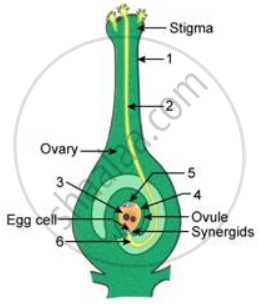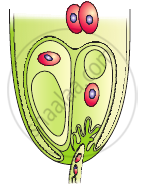Advertisements
Advertisements
प्रश्न
Describe any two devices in a flowering plant which prevent both autogamy and geitonogamy.
उत्तर
Two devices which prevent both autogamy and geitonogamy in flowering plants are:
1) In some species, pollen release and stigma receptivity are not synchronised. In this case, either the pollen is released before the stigma becomes receptive or the stigma becomes receptive much before the release of the pollen.
2) In another method, the anther and stigma are placed at the different position so that the pollen does not come in contact with the stigma of the same flower.
APPEARS IN
संबंधित प्रश्न
What is double fertilisation? Describe the process in brief.
Match the items in Column A with those in Column B.
|
Column A |
Column B |
|
(a) Generative nucleus |
(i) Pollen tube |
|
(b) Germ pore |
(ii) Endosperm nucleus |
|
(c) Exine |
(iii) Testa |
|
(d) Secondary nucleus |
(iv) Fertilization |
|
(e) Integument |
(v) Male nuclei |
|
(f) Egg nucleus |
(vi) Rough |
Name of the part of the ovary which gives rise to:
Seed ______
Given ahead is a diagrammatic representation of the process of fertilization. Study the same and then answer the question that follows:

What happens to
i) Ovary
ii) Ovule after fertilisation
Describe the process of double fertilization in angiosperms and add a note on its significance.
The seed is a fertilized _______.
In Haplopappus gracilis, number of chromosomes in cells of nucellus is 4. What will be the chromosome number in Primary endosperm cell?
In majority of plants pollen is liberated at
Pollen tube was discovered by
The success of seed plants on land is mainly due to ______.
By which of the following the megasporangium proper of an angiosperm ovule is represented?
Due to which of the following reasons the pollen tube usually grows down towards the egg?
By which of the following double fertilization is exhibited?
Identify the function of filiform apparatus.
Double fertilization is characteristic of ______.
Double fertilization is a distinctive feature of ______.
In the figure given below label the following parts: male gametes, egg cell, polar nuclei, synergid and pollen tube

Select the option that shows the correctly identified 'U', 'X', 'Y' and 'Z' in a developing dicot embryo.

